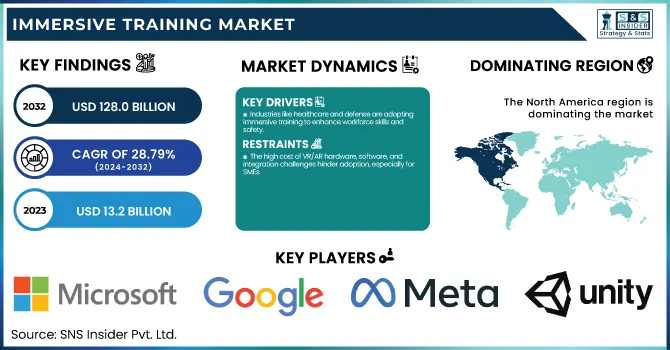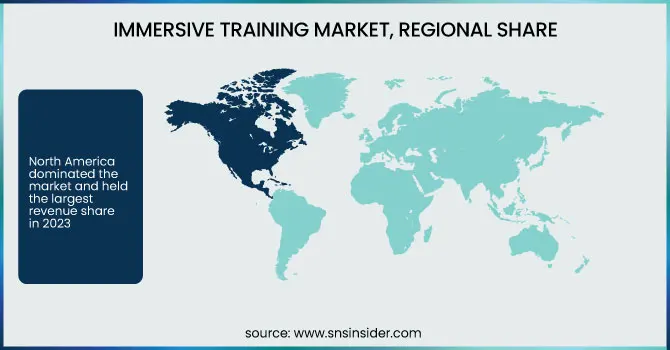Immersive Training Market Report Scope & Overview:
The Immersive Training Market was valued at USD 13.2 Billion in 2023 and is expected to reach USD 128.0 Billion by 2032, growing at a CAGR of 28.79% from 2024-2032.

To Get more information on Immersive Training Market - Request Free Sample Report
The adoption of immersive training solutions varies by industry, with healthcare, defense, and manufacturing leading due to high-risk training demands. VR and AR training usage differs across regions, with North America and Europe making significant investments, while Asia-Pacific experiences rapid growth driven by industrial expansion. Investments in immersive training technologies are increasing across corporate training, education, and simulation-based learning, driven by cost efficiency and enhanced learning outcomes. Research shows that immersive training outperforms traditional methods, offering greater engagement, improved retention, and better real-world skill application.
Market Dynamics
Drivers
-
Industries like healthcare and defense are adopting immersive training to enhance workforce skills and safety.
Healthcare, defense, aerospace, and manufacturing industries require risk-free training environments to improve skills in the workforce. Augmented and Virtual Reality-based immersive training solutions deliver engaging, real-life simulations, significantly boosting retention and enhancing on-ground operational performance. Due to the increased complexity of the tasks, organizations have been prioritizing safety and cost-effective training methods that will rely less upon physical resources. Moreover, developments in AI-powered simulations also improve real-time decision-making, which makes immersive training vital for skills development in the workforce. The increasing need for reskilling employees and bridging skill gaps contributes to adopting immersive training solutions across diverse industries, thereby boosting market growth.
Restraints
-
The high cost of VR/AR hardware, software, and integration challenges hinder adoption, especially for SMEs.
Like any new technology, immersive training requires high upfront investments in hardware, software, and content creation; its long-term gains are massive, but therefore, so be the initial cost. SMEs may not be able to afford the high-performance VR headsets/AR devices computing infrastructure that businesses need. Moreover, the technical integration of immersive training solutions with the existing learning management systems is another challenge. Poor simulation design capabilities and fears regarding cybersecurity risks also impede adoption. This makes many organizations reluctant due to unclear ROI potential and that a system will need to be constantly updated. Such parameters restrict mass adoption, particularly in low-margin sectors and countries, causing market growth to lag.
Opportunities
-
AI-driven adaptive learning and cloud-based deployment enhance accessibility, scalability, and cost efficiency.
Immersive training solutions are being designed to exploit the latest developments in Artificial Intelligence and cloud computing. Adaptive Learning powered by AI is the latest approach that personalizes learning by measuring how each individual is progressing and providing relevant feedback. The cloud allows you to make immersive training modules accessible from anywhere, reducing the cost of having infrastructure while at the same time increasing scalability. Training programs can be deployed across the globe with no geographical limitations which is especially useful for industries like healthcare, aviation, and retail among others. Moreover, analytics powered by AI provide insight into trainee performance that helps in making training more effective. As technology advances, AI and cloud integration represent a commercial opportunity for companies to create affordable, flexible, and scalable immersive training solutions.
Challenges
-
Creating high-quality immersive content is costly, time-consuming, and lacks standardization across industries.
Creating quality immersive training content demands exceptional skills in 3D modeling, AI-driven interactions, and real-time simulations. Because there are no standardized frameworks for VR/AR content creation, interoperability becomes a challenge between platforms. As a result, each industry has its own exclusive training needs, making custom content creation imperative, which consequently drives up production time and costs. Moreover, it is challenging to maintain effortless integration with myriad hardware devices and software ecosystems. These immersive technologies evolve at a breathtaking pace, requiring constant adjustments to refresh content and inflate development costs. To tackle these challenges, everyone from content developers to hardware manufacturers to regulatory agencies must find a way to reach a consensus on best practices to simplify the creation of immersive training content to meet needs.
Segmentation Analysis
By Component
In 2023, the hardware segment dominated the market and accounted for 47% of revenue share in 2023. This is primarily due to the high demand for next-gen devices including virtual reality headsets and augmented reality glasses. With better devices that can provide lifelike and dynamic experiences, organizations across different sectors such as gaming, healthcare, and education are increasingly investing in iterative technologies.
The software segment is expected to register the fastest CAGR during the forecast period, as the continuous rise in new applications based on immersive technologies seeks to address consumer preferences. With more industries realizing the high potential of VR & AR for training, simulation, and interactive experiences – the demand for software solutions that develop and manage such environments is gradually increasing.
By Technology
The virtual reality segment dominated the market and held the largest revenue share in 2023, owing to widespread adoption across several industries, including education and corporate training. VR Technologies offer immersive experiences that make way for greater learning outcomes as users can train real-life skills and processes in simulations that resemble the real world. With VR being proven to enhance retention and engagement it is a natural fit for organizations that are now investing effectively in content and VR technology for innovative training solutions.
The mixed reality segment is anticipated to register the fastest CAGR during the forecast period, due to its facility to combine the most useful parts of both augmented and virtual reality. MR enables simultaneous interaction with digital content and real-world environments, making it more versatile, resulting in applications that enhance training in various industries such as healthcare, manufacturing, and education.
By Industry
The gaming segment dominated the market and accounted for a significant revenue share in 2023, owing to the groundbreaking advancement made by immersive technologies including virtual reality and augmented reality. These technologies have successfully exploited the gaming industry by creating realistic and interactive environments that not only boost user engagement but also improve user experience.
The healthcare segment is anticipated to grow at the fastest CAGR during the forecast period as the adoption of immersive technologies is increasing rapidly in the healthcare sector for training and patient care. VR and AR in Healthcare are revolutionizing the ways medical science is researched, taught, and learned, and it provide realistic simulations, which improves the education outcome and reduces errors.
Regional Landscape
North America dominated the market and held the largest revenue share in 2023. More companies are realizing the benefits of immersive technologies for training, marketing, and customer engagement. And, last but not least, the growth of social VR platforms and the idea of the Metaverse creates new opportunities for putting our heads together and working in a collaborative space, thus also spurring investments in immersive training solutions.
Asia-Pacific is expected to register the fastest CAGR during the forecast period, including rapidly growing digital content consumption as well as streaming service growing in constellation progression but both centered on the fast-tracking demand for new digital media with limited training development investment. This trend is driven by regional countries that have a huge following actively keeping tabs on immersive training productions from both local and abroad.

Get Customized Report as per Your Business Requirement - Enquiry Now
Key Players
The major key players along with their products are
-
Microsoft – HoloLens 2
-
Meta (formerly Facebook) – Quest 3
-
HTC Corporation – VIVE Focus 3
-
Samsung Electronics – Samsung Gear VR
-
Sony Interactive Entertainment – PlayStation VR2
-
Google LLC – Google Tilt Brush
-
Magic Leap, Inc. – Magic Leap 2
-
Unity Technologies – Unity Engine
-
Pico Interactive – Pico 4 Enterprise
-
EON Reality – EON-XR Platform
-
Strivr Labs, Inc. – Strivr VR Training
-
Virti – Virti AI-powered Training
-
Oculus (a division of Meta) – Oculus for Business
-
WorldViz – Vizard VR Development Platform
-
zSpace, Inc. – zSpace Learning System
Recent Developments
-
September 2024: UPS expanded its use of virtual reality (VR) to train drivers in areas such as package stacking and handling field situations, including dog attacks.
-
October 2024:Emirates launched the MIRA VR training platform for its 23,000 cabin crew, focusing on Safety and Emergency Procedures (SEP) training for Airbus A380, Boeing 777, and Airbus A350 aircraft.
|
Report Attributes |
Details |
|
Market Size in 2023 |
USD 13.2 Billion |
|
Market Size by 2032 |
USD 128.0 Billion |
|
CAGR |
CAGR of 28.79% From 2024 to 2032 |
|
Base Year |
2023 |
|
Forecast Period |
2024-2032 |
|
Historical Data |
2020-2022 |
|
Report Scope & Coverage |
Market Size, Segments Analysis, Competitive Landscape, Regional Analysis, DROC & SWOT Analysis, Forecast Outlook |
|
Key Segments |
• By Component (Hardware, Software, Services) |
|
Regional Analysis/Coverage |
North America (US, Canada, Mexico), Europe (Eastern Europe [Poland, Romania, Hungary, Turkey, Rest of Eastern Europe] Western Europe] Germany, France, UK, Italy, Spain, Netherlands, Switzerland, Austria, Rest of Western Europe]), Asia Pacific (China, India, Japan, South Korea, Vietnam, Singapore, Australia, Rest of Asia Pacific), Middle East & Africa (Middle East [UAE, Egypt, Saudi Arabia, Qatar, Rest of Middle East], Africa [Nigeria, South Africa, Rest of Africa], Latin America (Brazil, Argentina, Colombia, Rest of Latin America) |
|
Company Profiles |
Microsoft, Meta (formerly Facebook), HTC Corporation, Samsung Electronics, Sony Interactive Entertainment, Google LLC, Magic Leap, Inc., Unity Technologies, Pico Interactive, EON Reality, Strivr Labs, Inc., Virti, Oculus (a division of Meta) |

